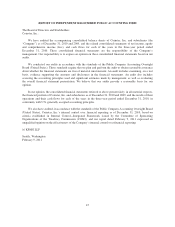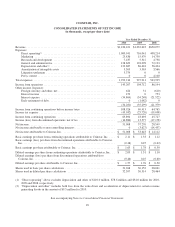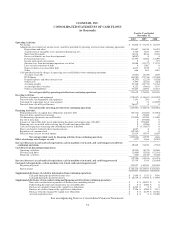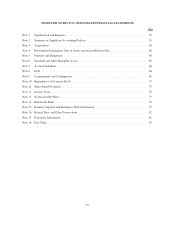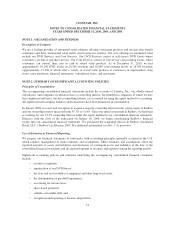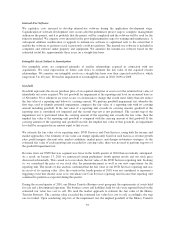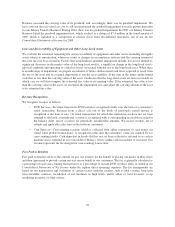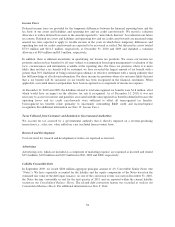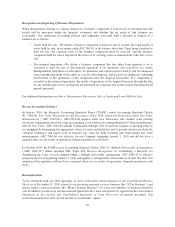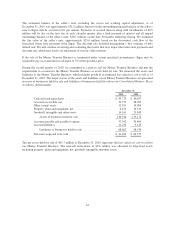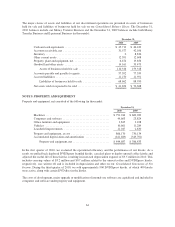Redbox 2010 Annual Report Download - page 64
Download and view the complete annual report
Please find page 64 of the 2010 Redbox annual report below. You can navigate through the pages in the report by either clicking on the pages listed below, or by using the keyword search tool below to find specific information within the annual report.Business exceeded the carrying value of its goodwill, and, accordingly, there was no goodwill impairment. We
have assessed the fair value less cost to sell and performed the goodwill impairment test each quarter thereafter
for our Money Transfer Business. During 2010, there was no goodwill impairment. In 2009, our Money Transfer
Business failed the goodwill impairment test, which resulted in a charge of $7.4 million in the fourth quarter of
2009 which is included as a component of income (loss) from discontinued operations, net of tax on our
Consolidated Statements of Income for 2009.
Lives and Recoverability of Equipment and Other Long-Lived Assets
We evaluate the estimated remaining life and recoverability of equipment and other assets, including intangible
assets subject to amortization, whenever events or changes in circumstances indicate that the carrying amount of
the asset may not be recoverable. Factors that would indicate potential impairment include, but are not limited to,
significant decreases in the market value of the long-lived asset(s), a significant change in the long-lived asset’s
physical condition and operating or cash flow losses associated with the use of the long-lived asset. When there
is an indication of impairment, we prepare an estimate of future, undiscounted cash flows expected to result from
the use of the asset and its eventual disposition to test the recoverability. If the sum of the future undiscounted
cash flow is less than the carrying value of the asset, it indicates that the long-lived assets are not recoverable, in
which case we will then compare the estimated fair value to its carrying value. If the estimated fair value is less
than the carrying value of the asset, we recognize the impairment loss and adjust the carrying amount of the asset
to its estimated fair value.
Revenue Recognition
We recognize revenue as follows:
• DVD Services—Revenue from movie DVD rentals is recognized ratably over the term of a consumer’s
rental transaction. Revenue from a direct sale out of the kiosk of previously rented movies is
recognized at the time of sale. On rental transactions for which the related movies have not yet been
returned to the kiosk at month-end, revenue is recognized with a corresponding receivable recorded in
the balance sheet, net of a reserve for potentially uncollectible amounts. We record revenue, net of
refunds and applicable sales taxes collected from consumers.
• Coin Services—Coin-counting revenue, which is collected from either consumers or card issuers (in
stored value product transactions), is recognized at the time the consumers’ coins are counted by our
coin-counting kiosks. Cash deposited in kiosks that has not yet been collected is referred to as cash in
machine and is reported in our Consolidated Balance Sheets within cash in machine or in transit. Our
revenue represents the fee charged for coin-counting transactions.
Fees Paid to Retailers
Fees paid to retailers relate to the amount we pay our retailers for the benefit of placing our kiosks in their stores
and their agreement to provide certain services on our behalf to our consumers. The fee is generally calculated as
a percentage of each coin-counting transaction or as a percentage of our net DVD revenues and is recorded in our
Consolidated Statements of Net Income under the caption direct operating expenses. The fee arrangements are
based on our negotiations and evaluation of certain factors with the retailers such as total revenue, long-term
non-cancelable contracts, installation of our machines in high traffic and/or urban or rural locations, co-op
marketing incentive, or other criteria.
56



